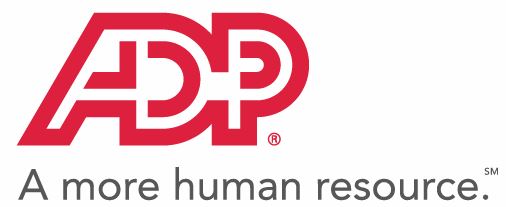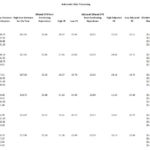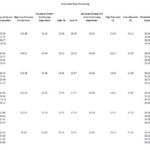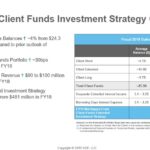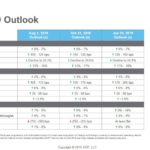Contents
Summary
- ADP reported Q2 2019 results on January 30th and raised its guidance for the remainder of FY2019.
- ADP continues to richly reward shareholders but shares appear to be overvalued.
- I plan to employ the conservative option strategy I successfully used in November 2018 to enhance my investment returns.
Introduction
Following Automatic Data Processing’s (NADAQ: ADP) Investor Day on June 12th in which management presented its:
- strategic vision,
- transformation initiatives,
- financial outlook,
I wrote this article on June 13th. In that article I came to the conclusion that:
‘I am in no rush to add to my existing ADP position and will continue to patiently wait for its stock price to retrace to a low 20s PE multiple….even if I have to wait several months!’
By late November I was of the opinion that ADP was even more overvalued than at the time of my June 13th article. I, therefore, decided to write December 2018 covered calls on the ADP shares we hold in one of our undisclosed retirement accounts which I touched upon in this article.
Fast forward to the December 2018 market pullback and the covered calls I wrote in November expired worthless thus allowing me to retain the $0.90/share option premium I had collected in November.
With the expiration of these options I was able to use the premium income to acquire additional ADP shares when ADP got caught up in the broad market pullback in December. In addition, the automatic reinvestment of the ADP dividends paid out at the beginning of January 2019 enabled me to acquire additional ADP shares.
ADP has now risen to $141.62 from the ~$122 low of December 24th and since it has just released Q2 2019 results and guidance for the remainder of FY2019 I am taking this opportunity to reanalyze ADP and to look at whether the conservative option strategy I employed in November is worth pursuing again.
In an effort to determine whether ADP’s current valuation based on guidance is reasonable I have undertaking a review of data going back to FY2007.
This analysis has been complicated slightly in that I have noticed that ADP’s diluted EPS and adjusted diluted EPS data is occasionally subsequently amended. On occasion, ADP’s 10-K for the year will reflect a figure for diluted EPS and adjusted diluted EPS but when I look at historical data in a future year’s 10-K, the diluted EPS and adjusted diluted EPS figures occasionally differ slightly.
For example, on page 17 of 140 in ADP’s FY2014 10-K, we see FY2014 diluted EPS from continuing operations of $3.11 and adjusted diluted EPS from continuing operations of $3.14.
If we look at page 20 of 139 in ADP’s FY2018 10-K, however, we see a restatement in FY2014 diluted EPS from continuing operations of $2.57 and adjusted diluted EPS from continuing operations of $2.57.
NOTE: I have also identified other discrepancies and await a reply from ADP’s Investor Relations Department regarding my February 1st email request for clarification on these discrepancies.
I do not know when I will receive a response to my inquiry but while I await a reply I have chosen to err on the side of caution in my analysis. Rather than use the diluted EPS and adjusted diluted EPS figures reflected in each year’s 10-K, I have opted to use to use the FY2018 10-K, for example, to gather the data I require for FY 2014 – 2018 (refer page 20 of 139). I have also followed a similar strategy to gather data for the 2007 – 2013 timeframe.
In the following images I have calculated ADP’s FY2007 – 2018 diluted PE and adjusted diluted PE on the basis of each fiscal year’s high and low share price. I have also calculated ADP’s dividend yield on the basis of each fiscal year’s high and low share price.
Later in this article I will refer to this historical data since I will compare current levels to these historical levels.
I recognize that the Broadridge (BR) business (spun off from ADP in 2007) and the CDK Global business (CDK) (spun off from ADP in 2014) will impact some of the historical data. I am also fully aware that during the period analyzed we also experienced a Financial Crisis which impacted just about every company out there. As a result, I am placing more reliance on the data for the last few years when comparing same to ADP’s current results.
Client Funds Portfolio Extended Investment Strategy
ADP believes client funds are fundamental to the underlying operations of its business model. In order to improve the company’s performance, ADP employs a strategy in which it generates income from significant client fund balances. When deemed prudent, ADP will further enhance its investment returns by investing long and borrowing short to take advantage of the yield spread.
These client funds are invested in accordance with ADP’s prudent and conservative investment guidelines and the credit quality of the investment portfolio is predominantly AAA/AA.
Compared to Q2 2018 we see that:
- Interest on funds held for clients increased 21% to $0.129B.
- Average client fund balances increased 5% to $23.6B.
- The average interest yield on client funds increased 30 bps to 2.2%.
Source: ADP – Q2 2019 Earnings Call Presentation – January 30 2019
The growth in balances was driven by a combination of client growth and wage inflation. This was offset by pressure from corporate tax reform and lower state unemployment insurance collections.
Q2 2019 Financial Results and FY2019 Outlook
ADP’s Q2 results can be accessed here.
Source: ADP – Q2 2019 Earnings Call Presentation – January 30 2019
On the Employer Services (ES) front, ADP is increasing revenue guidance to 5% – 6% from previous 4% – 6% guidance.
Due to margin outperformance in Q2, ADP is raising ES margin outlook to 175 – 200 bps from prior 150 – 175 bps forecast.
On the Professional Employer Organizations (PEO) front, ADP now expects 9% – 10% revenue growth versus prior forecast of 8% – 9% growth.
Better than expected performance in PEO margin in Q2 has resulted in ADP now expecting margins to be at least flat compared to the prior forecasted 25 – 50 bps reduction.
Total revenue growth of 6% – 7% is now forecast for FY2019 and client fund interest revenue has been revised to $90 – $100 million versus the prior $70 – $80 million.
Adjusted EBIT margin is expected to expand 125 – 150 bps from 20.7% in FY2018 versus the prior forecast of a 100 – 125 bps increase.
Guidance calls for a slower pace of margin expansion in the latter half of FY2019. ADP continues to expect lower top line revenue growth while, at the same time, maintaining investments into the business and the continued catch up on backfill hiring plans related to ADP’s voluntary early retirement program.
ADP is also amending its adjusted effective tax rate expectation to 24.4% versus the previous 24.5% projection.
Finally, ADP now expects adjusted diluted EPS to grow 17% – 19% versus its prior forecast of 15% – 17%.
In the January 30, 2019 Earnings Release ADP indicated it now expects diluted EPS growth of 20% – 22% from $4.25 in FY2018. This is puzzling given that ADP reported $3.66 in FY2018 diluted EPS.
ADP has also projected adjusted diluted EPS growth of 17% – 19% from $4.53 in FY2018. ADP, however, reported $4.35 in adjusted diluted EPS.
The FY2018 diluted EPS and adjusted diluted EPS figures for FY2018 and be found in the Q4 and FY2018 Earnings Release dated August 1, 2018.
I await a reply from ADP’s Investors Relations department on the above noted discrepancies.
Credit Ratings
Moody’s continues to rate ADP’s long-term debt Aa3. This is the lower tier of the High Grade category.
S&P Global rates ADP’s long-term debt AA. This is the middle tier of the High Grade category.
These ratings are acceptable for my purposes.
Valuation
At the time of my February 1, 2018 article, ADP had closed at $123.63 on January 31, 2018. Adjusted diluted EPS projections for FY2018 were ~$4.16 which resulted in a forward adjusted diluted PE of 29.72. I viewed that level as somewhat elevated and indicated I would patiently wait for a pullback.
When I wrote my June 13, 2018 article ADP was trading at ~$139. Management had just revised FY2018 adjusted EPS guidance to 16 – 17% growth from $3.70 reported for FY2017 thus giving us an anticipated adjusted EPS range of ~$4.29 – ~$4.33; the forward adjusted PE of ~32.1 – ~32.4 was even greater than at the time of my February 1st article.
With ADP having closed at $141.62 on February 1, 2019 let’s see how ADP’s valuation stacks up with previous levels.
I mentioned earlier that the January 30, 2019 Earnings Release calls for diluted EPS growth of 20% – 22% from $4.25 in FY2018. This would give us a $5.10 – $5.185 forward diluted EPS range and a forward diluted PE range of ~27.3 – ~27.8.
If we use the $3.66 in FY2018 diluted EPS reported on ADP FY2018 10-K, however, and increase this by 20% – 22% we get a $4.39 – $4.47 forward diluted EPS range and a forward diluted PE range of ~31.68 – ~32.26.
Let’s look at ADP’s valuation on the basis of projected adjusted diluted EPS growth of 17% – 19% from $4.53 in FY2018 and the $4.35 in adjusted diluted EPS ADP actually reported.
Increase $4.53 by 17% – 19% and we get $5.30 – $5.39 and an adjusted diluted forward PE range of ~26.27 – ~26.72. Using $4.35 we get $5.09 – $5.18 and an adjusted diluted forward PE range of ~27.34 – ~27.82.
Compare the forward valuations based of FY2019 projections and the current stock price with the results found in the Historical Valuation Analysis for 2007 – 2018 provided earlier in this article and it seems that the current valuation is closer to the high PE and high adjusted PE levels from recent years.
ADP’s dividend history found on its website is outdated. The most recent current dividend reflected on ADP’s website is the $0.69 dividend which was paid July 1, 2018.
We know, however, that ADP increased its quarterly dividend by $0.10 to $0.79 (see November 6, 2018 Press Release); this was a ~14.5% increase. The dividend increases in 2018 were somewhat higher than historical levels and this was attributed to the benefits received from tax reform.
On January 15, 2019, ADP declared a regular quarterly dividend of $0.79/share payable April 1, 2019 to shareholders of record on March 8, 2019; I envision ADP’s dividend will remain constant for another 2 quarters after the April 1, 2019 payment.
Looking at ADP’s historical dividend increases, I do not envision another dividend increase of ~14.5% to be announced in November 2019. In my opinion, an increase within the 7% – 9% range would be more in keeping with historical levels.
Even though ADP has increased its dividend for 44 consecutive years, dividend increases are not guaranteed. As a result, I am being conservative and will use four quarterly $0.79 dividends to determine ADP’s current dividend yield. The $3.16 in dividends for the year provides investors with a ~2.23% dividend yield on the basis of the current $141.62 share price.
If we compare this dividend yield to the historical dividend yield calculations found in the Historical Valuation Analysis for 2007 – 2018 provided earlier in this article, the current dividend yield appears to be closer to the dividend yields when ADP’s share price for the year was at the high end versus the dividend yield on the basis of ADP’s share price for the year being at the low end.
ADP also rewards investors through its long-standing share buyback program. In FY2008, there were ~527 million shares outstanding. As at the mid-point of FY2019 the Diluted weighted average shares outstanding is 438.9 million.
Option Strategy
I am of the opinion that ADP is too expensive at this stage to acquire more shares. As a result, I am looking to employ the use of a conservative covered call option strategy on a portion of my ADP shares which are held in an undisclosed account. My rationale for doing so is to generate additional income while exposing myself to a low probability of having my shares called away.
My intent is to write 5 $155 May 17, 2019 covered call contracts; the last price for this contract is $1.90. I would generate $950 less minimal online brokerage fees; keep in mind that each contract represents 100 shares.
If the stock price remains below $155 then the option buyer will not exercise the option to acquire shares at $155 and I will retain my shares and the option premium I collected.
Should ADP’s share price rise above $155 then the option buyer would exercise the option to acquire shares at $155 and I would forego the difference between the current share price and the $155 strike price.
ADP’s high price for the year is $153.51 and I think there is a greater probability of ADP trading below $155 between now and May 17th than above this level.
Should ADP’s stock price rise above $155 there is the strong probability my shares will be called away. Since I do not want to part with my ADP shares I would close out the contracts and writing new covered calls with an expiry date for a later month.
In addition to being of the opinion ADP shares would be excessively overvalued at $155, I also think there is a good probability of a broad market pullback between now and May 17th. As a result, I think this is an opportune time to employ the use of this conservative covered call option strategy again.
Final Thoughts
Based on my analysis I am of the opinion that ADP is richly valued. While there certainly is a possibility that ADP’s share price could be bid up from current levels I do not think investors will bid up the share price to $155 between now and May 17th. As a result, my intent is to employ the use of a covered call option strategy to extract additional income and this might be a strategy you may wish to employ if you own ADP shares.
If you do not own ADP shares, however, my advice is to hang tight and to wait for ADP’s share price to retrace to the ~$130ish level or below.
I hope you enjoyed this post and I wish you much success on your journey to financial freedom.
Thanks for reading!
Note: I sincerely appreciate the time you took to read this article. Please send any feedback, corrections, or questions to charles@financialfreedomisajourney.com.
Disclaimer: I have no knowledge of your individual circumstances and am not providing individualized advice or recommendations. I encourage you not to make any investment decision without conducting your own research and due diligence. You should also consult your financial advisor about your specific situation.
Disclosure: I am long ADP.
I wrote this article myself and it expresses my own opinions. I am not receiving compensation for it and have no business relationship with any company whose stock is mentioned in this article.


